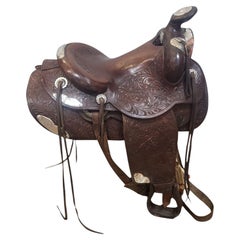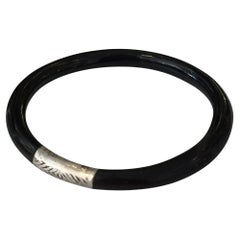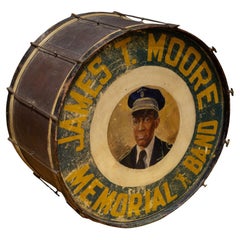Edward H Bohlin
Edward Bohlin was born in 1895 in Sweden.He ran away from home at age 15, working his way to America on a huge four-mast schooner with dreams of Buffalo Bill Cody's Wild West in his head. Bohlin worked cattle drives around Montana before opening his first saddle shop in Cody in Wyoming, where he did rope tricks in front of his shop to draw business. He met Tom Mix while performing at the Pantages Theatre in Hollywood and Mix convinced Ed to stay and produce silver and leather items in the Los Angeles area. From his humble beginnings to his fame in Hollywood for high-end pieces, he crafted more than 12,000 Bohlin saddles, including many grand silver outfits of Tournament of Roses Parade fame. He also dressed many silver screen heroes and horses with his grand style of buckles, spurs and gun belts. His company was without equal among western style silversmiths building a reputation on flawless workmanship. The Edward H Bohlin company, which operated from the early 1920s through the 1980s (under Ed's watchful eye but continues to operate under other ownership), reached its apex in the 1930s, when the Hollywood cowboys reigned supreme. Bohlin was a stickler for details and employed the finest silver and leather workers of his era to satisfy discriminating clients, including Mae West, Hopalong Cassidy, Monte Hale, Lyndon Johnson and Ronald Reagan. Bohlin Saddles Roy Roger's Diamond Special Bohlin Saddle Ed Bohlin was known for his beautifully crafted parade saddles.
A perfectionist for good and bad, he never accepted anything less than the best craftsmanship. The leather on his saddles still squeaks after 60 years. The silver requires only a cloth to clean because he used the highest grade of sterling. He and his artisans made many of the pieces by hand, especially the gold figures on his saddles. His carving was stunning and recognizable. Many of High Noon's customers remember going into Bohlin's shop as children while their fathers purchased saddles, buckles, belts, bolos and money clips. Some time the kids got a special gift, too, from their dads. A few child's saddles (The Jackie Cooper model) were made to match their fathers' for parades. The Tim McCoy model and others were made for the stars of the era. Fiesta was truly a work of art, both in the silver and the pictorial carving. The Murietta was one of his brilliant models, mounted with Indian and Tepee design with distant hills all done in three shades of gold. The Dicksons were used many times for riders who wanted to twinkle with silver in parades.
Bohlin saddles have always been valued higher than any other maker and have kept their value throughout the years. Both riders and collectors of Western Americana still clamor for Bohlin, whether they plan to ride using them or only to display them proudly in their offices or living rooms as art. Bohlin Buckles Edward H. Bohlin's filigree gold buckle Ed wanted the riders of his saddles to look elegant and match the beauty and artistry of the outfit. He made fine matching vests, chaps, belts, gunbelts, bolos, hat bands and buckles to dress his riders. The most personal of Bohlin's buckles were made, some by his hand. He made buckles to honor horses, longhorns, rodeos, ranches and women. He used sterling silver, gold (in 3 colors) rubies and diamonds. He cut the metals to form lacy overlays and bound the edges to look like rope. Matching gun belts were made of the same fine leather of the saddles with the same elegant silver spots and engraving. Special gun grips were fastened to Colts and other pistols and shotguns, all sterling silver and gold with matching buckles. Bohlin spurs are also highly coveted.
Bohin made magic with plain Crockett blanks, when he covered them with fine silver and gold, making leather straps and conchos to match. The same for bits, which were highly sought after and matched the headstalls and breast collars of the parade outfits. Bohlin also had a sense of humor and would make anything the clients wanted. Mae West was a favorite and he fashioned a sterling silver telephone for her use. He made silver picture frames, pins, conchos, bolos, satchels and desk sets. Bohlin loved his customers and they loved him. Memories of Bohlin in his shop are still vivid whenever you slip that leather belt around your waist and cinch it up with that Bohlin buckle.
Mid-20th Century American Edward H Bohlin
Sterling Silver
1930s American Art Deco Vintage Edward H Bohlin
Bakelite
Early 20th Century American Industrial Edward H Bohlin
Brass
20th Century American Edward H Bohlin
Leather
1960s Danish Scandinavian Modern Vintage Edward H Bohlin
Sterling Silver
1940s American Vintage Edward H Bohlin
Silver
1940s Mexican Mid-Century Modern Vintage Edward H Bohlin
Silver, Sterling Silver
Early 20th Century American Edward H Bohlin
Leather
1920s American Vintage Edward H Bohlin
Cotton
Mid-20th Century American Edward H Bohlin
Leather
Mid-20th Century Scandinavian Scandinavian Modern Edward H Bohlin
Gold, Sterling Silver
Late 20th Century American Edward H Bohlin
Leather
21st Century and Contemporary American Edward H Bohlin
Leather


